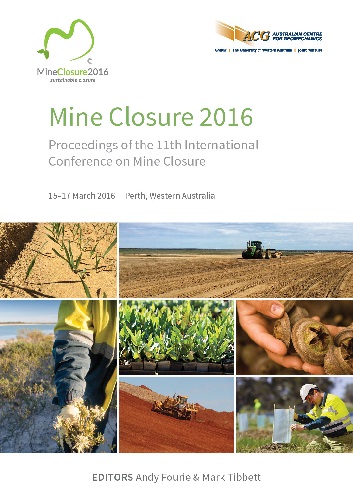Surface water assessments — critical for effective landform design

|
Authors: Smedley, E; Mackenzie, S; Gregory, S |
DOI https://doi.org/10.36487/ACG_rep/1608_35_Smedley
Cite As:
Smedley, E, Mackenzie, S & Gregory, S 2016, 'Surface water assessments — critical for effective landform design', in AB Fourie & M Tibbett (eds), Mine Closure 2016: Proceedings of the 11th International Conference on Mine Closure, Australian Centre for Geomechanics, Perth, pp. 481-494, https://doi.org/10.36487/ACG_rep/1608_35_Smedley
Abstract:
Surface water impacts can represent a significant long term mine closure risk in general and for landform design specifically, particularly in arid environments due to a range of factors including erosion, geotechnical instability and changes to geochemical conditions associated with water movement through landforms. Undertaking targeted surface water closure assessments during the landform design phase can provide an effective mechanism to define and manage drainage risks. Surface water assessments utilise a hydrological model to determine the runoff generated from catchments under design rainfall conditions in order to develop a hydrograph as an input into a hydraulic model. The hydraulic model assesses the performance of the surface water controls under the modelled conditions. The surface water assessment should be informed by the critical return period for any given site. Effective waste rock characterisation provides inputs for modelling the as-constructed hydraulic properties and an indication of how these properties may change over time. Surface water assessments are critical to develop closure designs that minimise the need for ongoing maintenance, are geared towards the achievement of long term closure objectives and are better able to meet stakeholder expectations. These assessments can provide key information to the landform design process, including drainage controls, storage features, slope configuration, upstream runoff management and armouring specifications. This paper explores the technical aspects of undertaking surface water assessments and provides practical working examples.
Keywords: surface water, drainage, landform design, surface stability
References:
Australian and New Zealand Minerals and Energy Council & Minerals Council of Australia 2000, Strategic Framework for Mine Closure.
BOM (Bureau of Meteorology) 2003, The estimation of probable maximum precipitation in Australia: Generalised short-duration method, Commonwealth Bureau of Meteorology.
BOM (Bureau of Meteorology) 2005, Guidebook to the estimation of probable maximum precipitation: Generalised tropical storm method, Australian Government Bureau of Meteorology, September 2005.
BOM (Bureau of Meteorology) 2014, Climate statistics for Australian locations, viewed 14 March 2014, climate/averages/
BOM (Bureau of Meteorology) 2015, Rainfall IFD data system, viewed 11 March 2015, Rainfalls/revised-ifd/?
Department of Industry, Tourism and Resources 2006, Mine Closure and Completion.
Department of Mines and Petroleum & Environmental Protection Authority 2015, Guidelines for Preparing Mine Closure Plans.
Fourie, AB & Tibbett, M 2007, ‘Post-mining landforms – Engineering a biological system’, in A Fourie, M Tibbett & J Wiertz (eds), Mine Closure 2007, Australian Centre for Geomechanics, Perth.
O’Loughlin, G 1993, The ILSAX program for urban stormwater drainage design and analysis, New South Wales Institute of Technology.
O’Loughlin, G & Stack, B 2013, DRAINS user manual, Watercom Pty Ltd.
Pilgrim, DH (ed) 1987, Australian Rainfall and Runoff – A guide to flood estimation, Institution of Engineers, Barton, Australian Capital Territory.
Sawatsky, L, McKenna, G, Keys, M & Long, D 2000, ‘Towards minimising the long-term liability of reclaimed mine sites’, in M Haigh (ed.), Reclaimed land: Erosion control, soils and ecology.
Smedley, E, Mackenzie, S, Astill, W, Campbell, G & Haymont, R 2014, ‘Cost effective integrated assessment of mine waste and practical management solutions’, in Goldfield Environmental Management Group, Goldfields Environmental Management Workshop 2014, Kalgoorlie-Boulder, Western Australia.
© Copyright 2025, Australian Centre for Geomechanics (ACG), The University of Western Australia. All rights reserved.
View copyright/legal information
Please direct any queries or error reports to repository-acg@uwa.edu.au
View copyright/legal information
Please direct any queries or error reports to repository-acg@uwa.edu.au